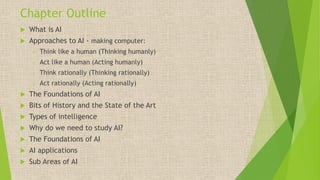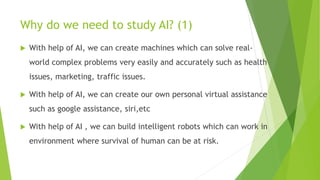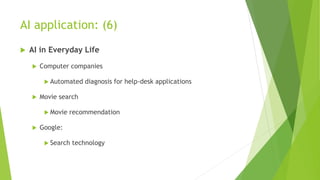AI Chapter I for Computer Science Students
- 2. Chapter Outline What is AI Approaches to AI - making computer: o Think like a human (Thinking humanly) o Act like a human (Acting humanly) o Think rationally (Thinking rationally) o Act rationally (Acting rationally) The Foundations of AI Bits of History and the State of the Art Types of intelligence Why do we need to study AI? The Foundations of AI AI applications Sub Areas of AI
- 3. INTRODUCTION TO AI Artificial intelligence (AI) is the intelligence of a machine or computer that enables it to imitate or mimic human capabilities. Artificial Intelligence is concerned with the design of intelligence in an artificial device. The term was coined by John McCarthy in 1956. Intelligence is the ability to acquire, understand and apply the knowledge to achieve goals in the world.
- 4. INTRODUCTION TO AI (1) AI uses multiple technologies that equip machines to sense, comprehend, plan, act, and learn with human-like levels of intelligence. Fundamentally, AI systems perceive environments, recognize objects, contribute to decision making, solve complex problems, learn from past experiences, and imitate patterns. These abilities are combined to accomplish tasks like driving a car or recognizing faces to unlock device screens.
- 5. INTRODUCTION TO AI (2) Artificial Intelligence is the development of computer systems that are able to perform tasks that would require human intelligence. Which is created by humans by loading suitable intelligent algorithms and a large volume of data to solve real world complex problems.
- 6. INTRODUCTION TO AI (3) AI can now take on many of the most repetitive jobs performed by humans with more accuracy and much faster. So that humans will be able to work less hours, having more free time to enjoy their life, family, hobbies, and friends.
- 7. INTRODUCTION TO AI (4) Artificial Intelligence made-up of two words: Artificial Produced by human art or effort, rather than originating naturally. Intelligence is the ability to acquire knowledge and use it" [Pigford and Baur]
- 8. INTRODUCTION TO AI (5)
- 9. INTRODUCTION TO AI (6) AI is a way to make machines think and behave intelligently. These machines are controlled by software inside them. It concerns with the way how machines to sense, reason, think, act. It is the branch of computer science by which we can create intelligent machines which can behave like human, thing like human and able to make decisions.
- 10. INTRODUCTION TO AI (7) With AI we don't need to preprogram the machine to do some work, We have create machine with programmed algorithm which can work with own intelligent which is awesomeness of AI. Machine Learning An application of AI that gives machines the ability to learn and improve without the help of humans or new programming.
- 11. How AI Works an AI system accepts data input in the form of speech, text, image, etc. The system then processes data by applying various rules and algorithms, interpreting, predicting, and acting on the input data. Upon processing, the system provides an outcome, i.e., success or failure, on data input. The result is then assessed through analysis, discovery, and feedback. Lastly, the system uses its assessments to adjust input data, rules and algorithms, and target outcomes. This loop continues until the desired result is achieved.
- 12. How AI Works (1)
- 13. Key Components of AI
- 14. Key Components of AI (1) 1. Machine learning: Machine learning is an AI application that automatically learns and improves from previous sets of experiences without the requirement for explicit programming. 2. Deep learning: Deep learning is a subset of ML that learns by processing data with the help of artificial neural networks. 3. Neural network: are computer systems that are loosely modeled on neural connections in the human brain and enable deep learning.
- 15. Key Components of AI (2) 4. Cognitive computing: Cognitive computing aims to recreate the human thought process in a computer model. It seeks to imitate and improve the interaction between humans and machines by understanding human language and the meaning of images. 5. Natural language processing (NLP): NLP is a tool that allows computers to comprehend, recognize, interpret, and produce human language and speech. 6. Computer vision: Computer vision employs deep learning and pattern identification to interpret image content (graphs, tables, PDF pictures, and videos).
- 16. What is the intelligence? Ability of problem solving The ability to think, plan and schedule The ability to Information manipulation Ability to tackle ambiguous problems Ability to learn and recognize Ability to understand and perceive
- 17. What is the intelligence? (1) Intelligence is made-up of following components:
- 18. Approaches to AI The exciting new effort to make computers thinks … machine with minds, in the full and literal sense” (Haugeland 1985) The automation of activities that we associate with human thinking, activities such as decision-making, problem solving, learning,…(Bellman, 1978)
- 19. Approaches to AI (1) “The art of creating machines that perform functions that require intelligence when performed by people” (Kurzweil, 1990) “The study of how to make computers do things at which, at the moment, people do better”, (Rich and Knight, 1991)
- 20. Systems that act like humans You enter a room which has a computer terminal. You have a fixed period of time to type what you want into the terminal, and study the replies. At the other end of the line is either a human being or a computer system. If it is a computer system, and at the end of the period you cannot reliably determine whether it is a system or a human, then the system is deemed to be intelligent. ?
- 21. Systems that act like humans The Turing Test approach a human questioner cannot tell if there is a computer or a human answering his question, via teletype (remote communication) The computer must behave intelligently Intelligent behavior to achieve human-level performance in all cognitive tasks
- 22. Systems that act like humans These cognitive tasks include: Natural language processing for communication with human Knowledge representation to store information effectively & efficiently Automated reasoning to retrieve & answer questions using the stored information Machine learning to adapt to new circumstances
- 23. The total Turing Test Includes two more issues: Computer vision to perceive objects (seeing) Robotics to move objects (acting)
- 24. Approaches to AI (2) “ The study of mental faculties through the use of computational models”,(Charniak et al. 1985) “The study of the computations that make it possible to perceive, reason and act”,(Winston, 1992)
- 25. Approaches to AI (3) “Computational Intelligence is the study of the design of intelligent agents” (Poole et al, 1998) “AI….is concerned with intelligent behavior in artifact”, (Nilsson, 1998)
- 26. How to Achieve AI? AI Acting humanly Thinking rationally Acting rationally Thinking humanly 26
- 27. Types of intelligence Logical-mathematical intelligence. Linguistic intelligence. Spatial intelligence. Musical intelligence. Intrapersonal intelligence. Interpersonal intelligence. Naturalistic intelligence.
- 28. Why do we need to study AI? One of the main reasons we want to study AI is to automate several real world complex problems. To Handle large amounts of data in an efficient way. Collect data simultaneously from multiple sources without any lag. Index and organize data in a way that allows us to derive insights. Learn from new data and update constantly using the right learning algorithms. Think and respond to situations based on the conditions in real time. Solving a problem in an easy manner.
- 29. Why do we need to study AI? (1) With help of AI, we can create machines which can solve real- world complex problems very easily and accurately such as health issues, marketing, traffic issues. With help of AI, we can create our own personal virtual assistance such as google assistance, siri,etc With help of AI , we can build intelligent robots which can work in environment where survival of human can be at risk.
- 30. Goals of AI To create Expert Systems: The systems which exhibit intelligent behavior, learn, demonstrate, explain, and advice its users. To replicate/implement human intelligence in machines: Creating systems that understand, think, learn, and behave like humans. Building a machine which can perform knowledge intensive tasks that requires human intelligent such as: Proving a theorem, playing chess, plan some surgical operations, and driving a car in traffic.
- 31. The Foundations of AI Academic disciplines important to AI: Philosophy: Logic, methods of reasoning, mind as physical system, foundations of learning, language, rationality. Can a machine think? Mathematics: Formal representation and proof, computation, probability. Neuroscience: neurons as information processing units. Brain architecture
- 32. The Foundations of AI (1) Academic disciplines important to AI: Psychology/ Cognitive Science: how do people behave, perceive, process information, represent knowledge. Computer engineering: to building fastest computers. Control theory: design systems that maximize an objective function over time. Linguistics: knowledge representation, grammar.
- 33. Applications of AI? Artificial Intelligence has various applications in today's society Following are some sectors which have the application of Artificial Intelligence:
- 34. AI applications: (1) Identification Technologies ID cards: E.G., ATM cards Can be a security risk: Cards can be lost, stolen, passwords forgotten, etc. Biometric identification: Walk up to a locked door Fingerprint device Iris scan Signature Voice pattern
- 35. AI application: (2) For Security application AI uses for Security applications For identifying face of crime makers For identifying some one from other Object identification
- 36. AI application: (3) Predicting the Stock Market Very difficult problem! Given the past, predict the future We can use learning algorithms to learn a predictive model from historical data Banks and financial traders used such models Association rule mining-to identify relations of different items
- 37. AI application: (4) Machine Translation Language problems is international business How hard is automated translation Very difficult! Ex: English to Russian, to Amharic, to Afan oromoo, to Tigrigna, to Sidama language, and other Ethio-local languages. Not only the words be translated, but also their meaning also! However AI Use algorithms which combine dictionaries, grammar models, etc.
- 38. AI application: (5) AI in Everyday Life Post office Automatic address recognition and sorting of mail Banks Automatic check readers, signature verification systems Automated loan application classification Telecom companies Automatic voice recognition for directory inquiries Credit card companies Automated fraud detection
- 39. AI application: (6) AI in Everyday Life Computer companies Automated diagnosis for help-desk applications Movie search Movie recommendation Google: Search technology
- 40. Sub Areas of AI: Game Playing Deep Blue Chess program beat world champion Gary Kasparov Speech Recognition PEGASUS spoken language interface to American Airlines' EAASY SABRE reservation system, Computer Vision Face recognition programs in use by banks, government, etc.
- 41. Sub Areas of AI: (1) Expert Systems Diagnostic Systems: MYCIN system for diagnosing bacterial infections System Configuration: DEC's XCON system for custom hardware configuration. Radiotherapy treatment planning. Financial Decision Making: Credit card companies, mortgage companies, banks. Classification Systems: NASA developed a system for classifying astronomical images
- 42. Sub Areas of AI: (2) Mathematical Theorem Proving Use inference methods to prove new theorems. Natural Language Understanding AltaVista's translation of web pages. Translation of Catepillar Truck manuals into 20 languages. Scheduling and Planning Automatic scheduling for manufacturing. Artificial Neural Networks: Machine Learning:
- 43. Sub Areas of AI: (3)
- 44. Current research areas of AI Current scholars of AI working on the following: Robotics Medical diagnosis Security application Language processing Vehicle riding Gamming Smart city / Smart environment Expert systems
- 45. Reading assignment History of AI






![INTRODUCTION TO AI (4)
Artificial Intelligence made-up of two words:
Artificial
Produced by human art or effort, rather than
originating naturally.
Intelligence
is the ability to acquire knowledge and use it"
[Pigford and Baur]](https://image.slidesharecdn.com/aichapteri1-240807145922-bef8d365/85/AI-Chapter-I-for-Computer-Science-Students-7-320.jpg)






































